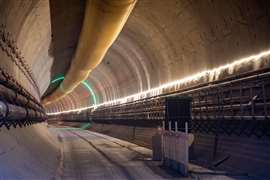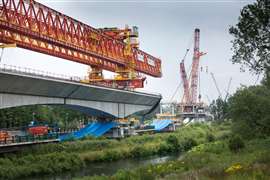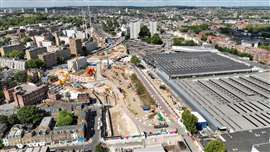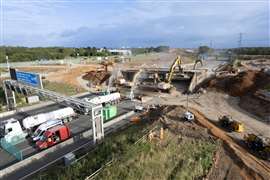Three reasons why costs on UK’s troubled high-speed rail megaproject HS2 have spiralled
20 November 2023
 HS2’s under construction Chiltern tunnel. Photo: HS2
HS2’s under construction Chiltern tunnel. Photo: HS2
Costs are continuing to rise on the UK’s troubled high-speed rail project HS2, which the UK government recently announced it would scale down significantly.
Last week, transport minister Huw Merriman issued a six-monthly update on the project, which revealed that the main work civils (MWCC) work alone has increased by another £6.1 billion (€7 billion), taking the latest cost projection (based on 2019 prices) to between £21.8 billion and £23.4 billion (€24.9 billion-€26.8billion).
The update came following Prime Minister Rishi Sunak’s announcement in October that significant parts of the HS2 project would be cancelled, axing everything outside of phase one, which runs from London to Birmingham. Sunak claimed not building the second phase of the line running to Manchester would save an estimated £36 billion (€41.1 billion).
Disagreement over total cost
The official overall budget for the project, based on an estimate released this spring, stands at £44.6 billion (€51 billion).
But it is likely to cost even more and the UK government’s Department for Transport and delivery company HS2 are at odds over just how much more
HS2 Ltd has estimated that in total, the estimate at completion will be between £49 billion and £57 billion based on 2019 prices (€56 billion-€65.2 billion). Merriman described this as a “very significant upwards revision” compared with previous projections.
The Department for Transport has made its own estimate of £45 billion to £54 billion (€51.5 billion-€61.8 billion) on the basis of the same data.
 Progress being made on the Colne Valley Viaduct - the UK’s longest rail bridge - in August 2023. (Image: HS2)
Progress being made on the Colne Valley Viaduct - the UK’s longest rail bridge - in August 2023. (Image: HS2)
Discussing the discrepancy before the Public Accounts Committee, a group of MPs who are scrutinising the cost of the project, Sir Jon Thompson, executive chair of HS2 Ltd said, “You have to make an assessment of how you are going to meet the schedule and if you don’t then you are going to end up with prolongation costs, which adds to the bill. That is why you end up with judgements and a range around the estimates.
“There’s also the question about risk. There is around £9 billion (€10.3 billion) in financial risk so for example what about tendering? What about if productivity does not improve? What about if efficiency doesn’t deliver against the targets and so on? There is a range of risks in here too and it is perfectly possible to take all of that information and take a different judgement. That is what I believe the department did when it came up with its £45 billion to £54 billion but I am happy to stick with my £49 billion to £56.6 billion.”
Responding to the comment, Alan Over, director general of the High Speed Rail Group and senior responsible owner (SRO) for HS2, said, “We have been working off the same data. It is because it is a matter of judgement about the extent to which future risks can be mitigated and in some areas around civils, systems and delay costs, we have taken a view that there is more ability to mitigate those risks than HS2 Ltd has. The overlap of the range is very significant.”
The two parties will have to reach an agreement on what they consider the lowest reasonable cost of the project to be in their next stage of work, although Over said there was a “high degree of commonality” between the two estimates.
Three reasons why costs have risen
Regardless of the outcome of those discussions, costs have risen again on the project since 2020 estimates. Asked to explain why this was the case, Dame Bernadette Kelly, permanent secretary within the Department for Transport, set out three reasons:
- External factors including covid, inflation, the Ukraine war, and supply chain issues.
- Planning and consenting. Dame Bernadette said this was “a continuing challenge which was anticipated”. But she added, “Perhaps the scale of some of the costs of mitigations that are required to deal with that were not [anticipated].”
- Poor cost information and cost reporting from the supply chain, as well as poor financial and risk management.
Dame Bernadette added, “I think the third area is really important and needs to be the focus of both Sir Jon’s work and ours in the department, addressing the root causes of why we are seeing this very large increase in costs.
“There are practical steps in relation to the main works civils contracts in particular and containing costs there that I think will be critical to ensuring that the cost increases don’t come in at the upper end of this scale. I don’t think we disagree on our analysis of the things that need to change and be improved both within the company and within the department’s oversight to manage these costs better going forwards.”
Cost-plus contracts make it hard to keep a lid on costs
Sir Jon Thompson explained that a decision by the government to award the main civils works contracts on a cost-plus basis made it difficult to keep a lid on the budget.
He said, “The big difference between the department’s spring estimate of £44.6 billion and now is about the main works civils contracts. 89% of the cost increase between then and now is down to those contracts.
 Aerial view of HS2’s London Euston construction site (Image: HS2)
Aerial view of HS2’s London Euston construction site (Image: HS2)
“The government’s decision to let a cost-plus contract where there are very few incentives or penalties around them does not provide me with any real levers on those contractors to do better in relation to schedule and costs. If they spend 100% more than what was originally agreed they only get a 1% reduction in their fee.
“I can attempt to see if we can reset that in some way but we are where we are and the decisions were made for all the right reasons (I assume) back in 2019 to let these contracts on this basis.”
Dame Bernadette explained that when tendering the contracts, the government had wanted to attract international construction companies to build HS2 and that the “risk allocation partly reflected the scale of those projects”.
She said that initial estimates on cost from would-be bidders was “very conservative” because they felt the contracts left them bearing too much risk.
“That resulted in the commercial structure we have now,” she said. “I recall that the National Audit Office’s view at the time was that this potentially did leave a lot of risk sitting with HS2 and the government and that it would need to be managed very rightly. In effect, I think we have to acknowledge now that we need to do better on the tight management of these contracts.”
Could design changes result in further cost increases?
 (PHOTO: HS2)
(PHOTO: HS2)
Following Sunak’s announcement that only Phase one of HS2 would be built, Sir Jon said that HS2 and the government would have to work together on the design, scope, and delivery of Euston station in London (which will go ahead but only if it can secure private investment), Handsacre Junction on the West Coast Mainline near Lichfield, and the rolling stock.
Had HS2’s Phase 2a running between Birmingham and Crewe been built, the new high-speed line would not have needed to run onto the West Coast Mainline at all but as it stands, there is now a potential “choke point” at Handsacre Junction where the line goes from six tracks, to four, to just two.
Sir Jon said HS2 Ltd was looking at whether the junction is big enough or needs to be bigger and what that could mean in terms of land acquisition and costs. He warned that considerations like this could push the cost of the project up.
Reorganisation within HS2
As of last week, Sir Jon has been in the role of executive chairman of HS2 for seven weeks, after former chief executive Mark Thurston stepped down earlier this summer.
A replacement CEO is expected to be appointed in 2024 alongside a chief railway officer.
Explaining the creation of the new post of chief railway officer, Sir Jon said, “One of the lessons to be learned from Crossrail is that you need to have a single, controlling mind for the programme overall, rather than working through individual lines.
“So you need to have someone who integrates the whole thing and thinks about the railway from in-service to now and how do you get there both as quickly as possible and as cheaply as possible.”
The first (and now only) phase of HS2 is due for completion in a window between 2029 and 2033.
STAY CONNECTED



Receive the information you need when you need it through our world-leading magazines, newsletters and daily briefings.
CONNECT WITH THE TEAM









